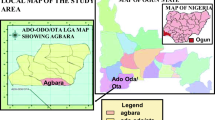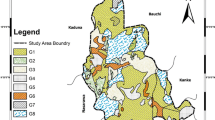Abstract
With a history of more than 200 years of tin mining, Bangka Island has brought along a byproduct of heavy minerals containing radionuclide elements. There are some concerns about this byproduct material contributing to natural radiation in the environment. In this study, a car-borne survey was conducted to accurately assess natural background radiation in Bangka Island. Indoor and outdoor ambient dose rates in 146 houses were also measured to assess the radiation dose from external exposure received by the public. Soil samples were collected and measured using a gamma spectroscopy system to evaluate the contributions of specific radionuclides to external terrestrial exposure. From 3790 measurement points during the car-borne survey, the highest ambient dose equivalent rate was 596 nSv h−1 measured in Muntok area, with a mean value of 101 nSv h−1 and a median value of 95 nSv h−1. The ambient dose equivalent rate distribution map showed a relatively higher value in the northern coastal area of the island, where the Pemali tin deposit is located. The annual effective dose received from external radiation in the 146 houses in Bangka Island ranged from 0.44 to 1.30 mSv year−1, with a median value of 0.66 mSv year−1. The soil contained a relatively high amount of thorium (232Th), which contributed 69% to external radiation exposure in Bangka Island.








Similar content being viewed by others
Data availability
All relevant data is in the paper.
References
Adelikhah M, Shahrokhi A, Imani M et al (2021) Radiological assessment of indoor radon and thoron concentrations and indoor radon map of dwellings in Mashhad. Iran Int J Environ Res Public Health 18:1–15. https://doi.org/10.3390/ijerph18010141
Ademola AK, Obed RI (2012) Gamma radioactivity levels and their corresponding external exposure of soil samples from tantalite mining areas in Oke-Ogun, South-Western Nigeria. Radioprotection 47:243–252. https://doi.org/10.1051/radiopro/2012003
Al-Sulaiti H, Nasir T, al Mugren KS et al (2012) Determination of the natural radioactivity levels in northwest of Dukhan, Qatar using high-resolution gamma-ray spectrometry. Appl Radiat Isot 70:1344–1350. https://doi.org/10.1016/j.apradiso.2011.11.015
Al-Zahrani JH (2017) Estimation of natural radioactivity in local and imported polished granite used as building materials in Saudi Arabia. J Radiat Res Appl Sci 10:241–245. https://doi.org/10.1016/j.jrras.2017.05.001
Agus C, Wulandari D, Primananda E et al (2017) The role of soil amendment on tropical post tin mining area in bangka island indonesia for dignified and sustainable environment and life. IOP Conference Series Earth Environ Sci 83(1):012030. https://doi.org/10.1088/1755-1315/83/1/012030
BPS-Babel (2022) Kepulauan Bangka Belitung Province in Figures 2022. BPS-Statistics of Kepulauan Bangka Belitung, Pangkal Pinang
Caridi F, Marguccio S, Durante G et al (2017) Natural radioactivity measurements and dosimetric evaluations in soil samples with a high content of NORM. Eur Phys J Plus 132:56. https://doi.org/10.1140/epjp/i2017-11343-x
Cetin E, Altinsoy N, Örgün Y (2012) Natural radioactivity levels of granites used in Turkey. Radiat Prot Dosim 151:299–305. https://doi.org/10.1093/rpd/ncs007
Emad BM, Sayyed MI, Somaily HH, Hanfi MY (2022) Natural radioactivity and radiological hazard effects from granite rocks in the Gabal Qash Amir Area, South Eastern Desert. Minerals 12:884. https://doi.org/10.3390/min12070884
Ibeanu IGE (2003) Tin mining and processing in Nigeria: cause for concern? J Environ Radioact 64:59–66. https://doi.org/10.1016/S0265-931X(02)00058-9
ICRP (2005) Protecting people against radiation exposure in the event of a radiological attack. ICRP Publication 96. Ann ICRP 35(1):51
ICRP (2010) Conversion coefficients for radiological protection quantities for external radiation exposures. ICRP Publication 116 Ann. ICRP 40:117–118
Hosoda M, Tokonami S, Omori Y et al (2015) Estimation of external dose by car-borne survey in Kerala, India. Plos One 10(4):e0124433. https://doi.org/10.1371/journal.pone.0124433
Hosoda M, Nugraha ED, Akata N et al (2021) A unique high natural background radiation area – dose assessment and perspectives. Sci Total Environ 750:142346. https://doi.org/10.1016/j.scitotenv.2020.142346
JCGM (2008) Evaluation of measurement data-Guide to the expression of uncertainty in measurement, JCGM 100:2008. Joint Committee for Guides in Metrology
Jibiri NN (2011) Terrestrial gamma dose rates and physical-chemical properties of farm soils from ex- tin mining locations in Jos-Plateau, Nigeria. Afr J Environ Sci Technol 5:1039–1049. https://doi.org/10.5897/ajest11.245
Karunakara N, Yashodhara I, Sudeep Kumara K et al (2014) Assessment of ambient gamma dose rate around a prospective uranium mining area of South India - a comparative study of dose by direct methods and soil radioactivity measurements. Results Phys 4:20–27. https://doi.org/10.1016/j.rinp.2014.02.001
Khan AUH, Blimkie M, Yang DS et al (2021) Effects of chronic low-dose internal radiation on immune-stimulatory responses in mice. Int J Mol Sci 22(14):7303. https://doi.org/10.3390/ijms22147303
Katsura M, Cyou-Nakamine H, Zen Q et al (2016) Effects of chronic low-dose radiation on human neural progenitor cells. Sci Rep 6:20027. https://doi.org/10.1038/srep20027
Kumara PARP, Mahakumara P, Jayalath A, Jayalath CP (2018) Estimating natural radiation exposure from building materials used in Sri Lanka. J Radiat Res Appl Sci 11:350–354. https://doi.org/10.1016/j.jrras.2018.07.001
Legasu ML, Chaubey AK (2022) Determination of dose derived from building materials and radiological health related effects from the indoor environment of Dessie city, Wollo, Ethiopia. Heliyon 8(3):e09066. https://doi.org/10.1016/j.heliyon.2022.e09066
Mendes WDC, Alves J, da Cunha PCR et al (2016) Potassium leaching in different soils as a function of irrigation depths. Rev Bras Engenharia Agricola e Ambiental 20:972–977. https://doi.org/10.1590/1807-1929/agriambi.v20n11p972-977
Ningappa C, Sannappa J, Karunakara N (2008) Study on radionuclides in granite quarries of Bangalore rural district, Karnataka, India. Radiat Prot Dosim 131:495–502. https://doi.org/10.1093/rpd/ncn203
Nugraha ED, Hosoda M, Kusdiana, et al (2021a) Comprehensive exposure assessments from the viewpoint of health in a unique high natural background radiation area, Mamuju, Indonesia. Sci Rep 11:14578. https://doi.org/10.1038/s41598-021-93983-2
Nugraha ED, Hosoda M, Tamakuma Y et al (2021b) A unique high natural background radiation area in Indonesia: a brief review from the viewpoint of dose assessments. J Radioanal Nucl Chem 330:1437–1444. https://doi.org/10.1007/s10967-021-07908-4
Omori Y, Tokonami S, Ishikawa T et al (2015) A pilot study for dose evaluation in high-level natural radiation areas of Yangjiang, China. J Radioanal Nucl Chem 306:317–323. https://doi.org/10.1007/s10967-015-4286-z
Omori Y, Hosoda M, Takahashi F et al (2020) Japanese population dose from natural radiation. J Radiol Prot 40:R99–R140
Permana S, Soedarsono JW, Rustandi A et al (2018) The enhancement of uranium and thorium in Bangka tin slag. Atom Indonesia 44:37–42. https://doi.org/10.17146/aij.2018.529
Pratiwi, Narendra BH, Mulyanto B (2020) Soil properties improvement and use of adaptive plants for land rehabilitation of post tin mining closure in Bangka Island, Indonesia. J Biol Biodiversity 21(2):505–511. https://doi.org/10.13057/biodiv/d210211
Reddy KU, Ningappa C, Sannappa J (2017) Natural radioactivity level in soils around Kolar Gold Fields, Kolar district, Karnataka, India. J Radioanal Nucl Chem 314:2037–2045. https://doi.org/10.1007/s10967-017-5545-y
Schwartz M, Surjono (1991) The Pemali tin deposit, Bangka, Indonesia. Miner Deposita 26:18–25
Shilfa SN, Jumpeno BYEB, Nurokhim, Kusdiana (2020) Ambient dose measurement from high natural background radiation (HNBR) in Botteng Utara Village Mamuju-Indonesia. J Phys Conf Ser 1436:012027. https://doi.org/10.1088/1742-6596/1436/1/012027
Sohrabi M (2013) World high background natural radiation areas: need to protect public from radiation exposure. Radiat Meas 50:166–171. https://doi.org/10.1016/j.radmeas.2012.03.011
Sukarman S, Gani RA, Asmarhansyah A (2020) Tin mining process and its effects on soils in Bangka Belitung Islands Province, Indonesia. Sains Tanah 17:180–189. https://doi.org/10.20961/STJSSA.V17I2.37606
Syarbaini K, Iskandar D (2015) Concentration of natural radionuclides in soil and assessment of external exposure to the public in Bangka - Belitung Islands, Indonesia. Int J Sustain Energy Environ 3:1–11
Syarbaini S, Setiawan A (2015) Terrestrial gamma radiation exposure in Bangka-Belitung Islands, Indonesia. Atom Indonesia 41:41–45. https://doi.org/10.17146/aij.2015.354
Syarbaini S, Pudjadi E (2015) Radon and thoron exhalation rates from surface soil of Bangka - Belitung Islands, Indonesia. Indones J Geosci 2:35–42. https://doi.org/10.17014/ijog.2.1.35-42
Syarbaini S, Warsona A, Iskandar D (2014) Natural radioactivity in some food crops from Bangka-Belitung Islands, Indonesia. Atom Indones 40:27–32. https://doi.org/10.17146/aij.2014.260
Shin E, Lee S, Kang H et al (2020) Organ-specific effects of low dose radiation exposure: a comprehensive review. Front Genet 11:566244. https://doi.org/10.3389/fgene.2020.566244
Tripathi RM, Sahoo SK, Jha VN et al (2011) Radiation dose to members of public residing around uranium mining complex, Jaduguda, Jharkhand, India. Radiat Prot Dosim 147:565–572. https://doi.org/10.1093/rpd/ncq496
UNSCEAR (2010) Annex B: Exposure of The Public and Workers from Various Sources of Radiation. In: Sources and effects of ionizing radiation. United Nation, New York, pp 327–339
UNSCEAR (2000) UNSCEAR 2000 Report to The General Assembly. In: Sources and Effects of Ionizing Radiation. United Nation, New York
UNSCEAR (2011) Report of the United Nations Scientific Committee on the Effects of Atomic Radiation 2010: fifty-seventh session, includes scientific report. United Nations, New York, Summary of low-dose radiation effects on health
Zglinicki K, Szamałek K, Wołkowicz S (2021) Critical minerals from post-processing tailing. A case study from Bangka Island, Indonesia. Minerals 11(4):352. https://doi.org/10.3390/min11040352
Acknowledgements
The authors acknowledge and are grateful to the author’s colleague from Bangka Island for the help during the investigation in study area.
Funding
This work was partially supported by the Japan Society for the Promotion of Science (JSPS) Environmental Radioactivity Network Center (ERAN) Grant No I-22–14, No I-23–25, No I-23–26 (25/III.2.7/HK/2022) (E.D.N), The Japan Society for the Promotion of Science (JSPS) KAKENHI Grant no. JP16K15368, JP16H02667, JP18KK0261, JP18K10023, JP20H00556 (S.T, M.H), the Hirosaki University Institutional Research Grant Health Research foundation (S.T; E.D.N; M.S), IREM-Hirosaki University (26/III.2.7/HK/2022) (E.D.N), Ministry of Research, Technology and Higher Education Indonesia and the Indonesia Endowment Funds for Education (LPDP) through the research fund Riset Inovasi untuk Indonesia Maju (RIIM) Grant No RIIM-16 (E.D.N). The Management Talenta-BRIN though the visiting researcher program 2022 (E.D.N; S.T; and Y.O).
Author information
Authors and Affiliations
Contributions
Conceptualization, E.D.N, and S.T.; methodology, E.D.N., M.H., and Y.O.; validation, R.P, and E.D.N.; formal analysis, E.D.N., and R.P; investigation, R.P., S.N.S, W., M.W., S.Y., H.N.E.S., S.W, D.I., U., A.D., H.P., I.D.W and E.D.N; resources, E.D.N, W, S.W., M.S, M.W and S.T.; data curation, E.D.N, R.P., W. and; writing—original draft preparation, R.P, and E.D.N; writing—review and editing, R.P., E.D.N., W, M.W., S.Y., H.N.E.S., S.N.S., C.K., A.D., H.P., I.D.W., E.E., N.N., D.I., G.S., M., E.H., S.W., M.H., Y.O., M.S., and S.T.; visualization, E.D.N.; supervision, E.D.N, M.H and S.T.; funding acquisition, M.S., E.D.N and S.T. All authors have read and agreed to the published version of the manuscript.
Corresponding author
Ethics declarations
Ethical approval
The study is not related to any ethical issues such as research involving animals and the protection of human subjects.
Consent to participate
All authors have agreed to participate and contribute to the published version of the manuscript.
Consent for publication
All authors have read and agreed to publish the final version of the manuscript.
Competing interests
The authors declare no competing interests.
Additional information
Responsible Editor: Georg Steinhauser
Publisher's note
Springer Nature remains neutral with regard to jurisdictional claims in published maps and institutional affiliations.
Rights and permissions
Springer Nature or its licensor (e.g. a society or other partner) holds exclusive rights to this article under a publishing agreement with the author(s) or other rightsholder(s); author self-archiving of the accepted manuscript version of this article is solely governed by the terms of such publishing agreement and applicable law.
About this article
Cite this article
Pradana, R., Nugraha, E.D., Wahyudi, W. et al. Car-borne survey and dose assessment from external radiation exposure in Bangka Island. Environ Sci Pollut Res 30, 89280–89292 (2023). https://doi.org/10.1007/s11356-023-28640-4
Received:
Accepted:
Published:
Issue Date:
DOI: https://doi.org/10.1007/s11356-023-28640-4




